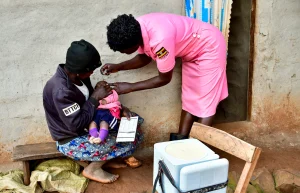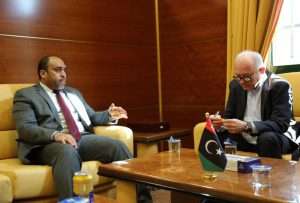Dr Ngozi Erondu: US health strategy risks widening inequality

In September, the long-anticipated America First Global Health Strategy (AFGHS) was released, a document whose very title feels inconsistent and exposes what many in the field have long understood: that global health, as practised, has rarely been truly global. Rather, it has often meant that a few countries and institutions have exerted overwhelming influence on the development and management of health policy and strategy in poorer countries.
The AFGHS reflects a clear logic of commercial diplomacy: using foreign assistance to advance American innovation abroad while reinforcing domestic economic interests. Roughly a quarter of its health funding is earmarked for commodities – diagnostics, medicines, and vaccines – with procurement preferences that privilege US-made products.

For Washington, this approach aligns health security with industrial competitiveness. For its partners in Africa and elsewhere, however, it risks hardening patterns of structural dependency precisely when they want to improve their own manufacturing and regulatory capacity.
Yet this challenge need not become a zero-sum equation. If negotiated strategically, the AFGHS could be part of a transitional compact – one that balances US industrial priorities with Africa’s long-term health security and economic sovereignty.
The good and the bad: Alignment in principle, retrenchment in practice
On the surface, the AFGHS call to reduce inefficiencies and improve accountability appears reasonable, even overdue. However, the mechanisms proposed often undercut that goal. The AFGHS leans heavily toward country-to-country deals while scaling back contributions to multilateral organisations that typically coordinate investments across diseases and regions.
This approach is particularly contradictory given that the diseases highlighted in the strategy – tuberculosis, HIV/AIDS, malaria, and polio – are precisely those for which multilateral platforms (such as the Global Fund and Gavi) have proven indispensable. Moreover, by focusing narrowly on these disease-specific programs, the strategy entrenches the vertical silos it critiques.
On one hand, the US decision to reduce reliance on large, international NGOs could, if properly managed, align with broader calls to boost local ownership of healthcare provision in poorer countries. On the other, the AFGHS reinforces a long-standing structural flaw in global health policy – the artificial separation between health security and health systems.
This approach treats health security elements such as disease surveillance, laboratory capacity, and stockpiling countermeasures like vaccines and personal protective equipment (PPE) as distinct technical functions rather than integral components of a functioning health system. That approach was proven inadequate during the COVID-19 pandemic, when several national health systems could detect threats but struggled to sustain a response or continue other essential health services.
In Africa – the main regional focus of the AFGHS – leaders are moving in the opposite direction, rallying behind the Lusaka Agenda and similar efforts to embed preparedness within healthcare systems.
In these respects, the AFGHS embodies a strategic contradiction: it affirms the principle of national ownership while simultaneously constraining it by seeking to dictate how poorer countries develop their health strategies and implement health programmes.
But even the strategy of a superpower should be viewed as an input among many, not mistaken as the roadmap itself. The AFGHS can contribute meaningfully to health security in Africa and globally, but only where it aligns with clear national and regional priorities and the broader imperatives of equity, mutual progress, and genuinely dignified partnership.
The possible: Preventing outbreaks through investment in PHC
Preventing outbreaks is an area of clear alignment. Without robust disease surveillance, countries cannot detect potential threats early or mount timely responses. Achieving the AFGHS’s 72-hour outbreak response ambition, for instance, requires more than emergency response functions. It depends on a durable backbone of public health infrastructure.
Countries can leverage US investments in surveillance to simultaneously strengthen their own public health networks and primary healthcare systems. This could include expanding community clinics to monitor symptoms and provide early warning; integrating laboratory and clinical sample referral systems; and digitizing health information flows to enable real-time decision making. Done deliberately, such measures would not only enhance surveillance capacity but also reinforce national health systems – turning external funding into structural resilience.

A second critical area is workforce strengthening. US expertise could be leveraged to promote shared data systems, cross-border cooperation, and harmonized analytic capacity across countries, enhancing regional intelligence and preparedness – and aligning with the WHO’s Collaborative Surveillance approach.
The AFGHS rightly points to the United States’ decades of investment in Field Epidemiology Training Programs (FETPs) globally. If sustained and regionally aligned, these programs could serve as powerful conduits for developing a skilled and interconnected public health workforce. Better connections between national programs through regional networks could be more effective and cost-efficient than deploying international personnel, ensuring rapid response through a regional workforce that shares similar health system contexts.
Such efforts could transform the AFGHS’s surveillance agenda from a narrow security tool into a driver of stronger regional cooperation, more equitable pandemic preparedness, and alignment with the goals of the forthcoming Pandemic Accord.
The possible: Shared security and regional self-reliance
The timing of AFGHS is opportune. While several facilities across Africa now manage the final stages of vaccine production – filling vials and packaging doses for distribution – the ability to produce the vaccine substance itself remains limited. But a genuinely integrated, end-to-end manufacturing ecosystem remains aspirational for Africa.
The African Union has expanded its vision beyond vaccines to include diagnostics, therapeutics, and essential health products, underpinned by commitments to expand workforce capacity, harmonise regulation, and coordinate investment.
As these capacities mature, African countries have a limited but critical window to align AFGHS with their own health security agendas. Countries could begin by agreeing to transitional procurement arrangements that initially reserve a majority share for US products but include sunset clauses, enabling substitution with local equivalents once they meet internationally recognised benchmarks.
As local production scales up – reaching targets in volume, certification, or cost parity – recipient countries’ co-financing contributions can rise proportionally, gradually loosening procurement restrictions and reinforcing national ownership.
AFGHS embodies a strategic contradiction: it affirms the principle of national ownership while simultaneously constraining it by seeking to dictate how poorer countries develop their health strategies and implement health programmes.
Bilateral agreements could also include buy-back provisions, where the US commits to purchasing a minimum quantity or value of locally manufactured products annually. That would stabilise market risk, enhance investor confidence, and anchor early-stage African manufacturers in global supply chains.
US financing and procurement oversight can also be used to drive up regulatory quality, data transparency, and excellence across African manufacturing hubs. As local suppliers achieve internationally recognised standards (such as WHO prequalification) they should become eligible to the same terms as US suppliers, with preferential consideration for inclusion in future procurement rounds.
If implemented in this spirit, the AFGHS could be transformed from a unilateral framework into a mutually reinforcing architecture – one that aligns short-term American economic interests with long-term African industrial resilience. This kind of graduated interdependence represents not a dilution of America First, but its evolution into ‘shared security through shared capacity’.
READ: Lorenzo Maria Pacini: Trump’s plan towards Ukraine’s “peace”
To be sure, serious challenges remain. The withdrawal of US funding from Gavi and the prospect of reduced contributions to the Global Fund risk undermining the multilateral architecture that has underpinned global health security for two decades. Equally concerning is the transactional calculus in the AFGHS, which privileges countries of strategic value over others, including some that may have the highest needs for investment. Such selectivity risks leaving critical gaps in surveillance and response – making both the US and the world less safe.
In the end, the America First Global Health Strategy is only as consequential as the responses it provokes. Countries that approach it as a negotiation rather than a directive, leveraging US resources to build their own capacity, will define the next phase of global health security.
The views expressed in this article belong to the author and do not necessarily reflect the editorial policy of Maghrebi.org. Dr Ngozi Erondu is an infectious disease epidemiologist and senior advisor in global health, bringing 20 years of experience supporting governments and organisations to strengthen systems and eliminate disease. This article was originally published by Chatham House.
If you wish to pitch an opinion piece, please send your article to grace.sharp@maghrebi.org.
Want to chase the pulse of North Africa?
Subscribe to receive our FREE weekly PDF magazine













